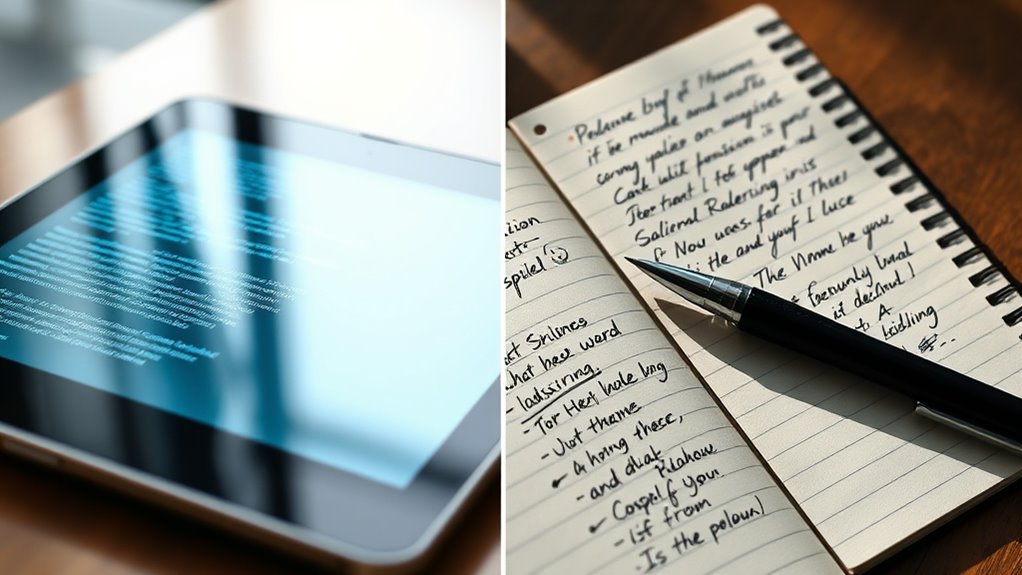Choosing between digital and handwritten notes depends on your learning style. Digital notes offer easy organization, quick access, and multimedia integration, making updates simple. Handwritten notes promote active engagement, deeper encoding, and better memorization through physical involvement. Both methods can boost your retention if you apply active techniques. To discover which suits you best and how to maximize each, exploring further will give you more useful insights.
Key Takeaways
- Digital notes offer easy organization, quick retrieval, and multimedia integration, enhancing efficiency and flexibility.
- Handwritten notes promote active engagement, deeper processing, and better memorization through physical involvement.
- Digital tools enable customizable review methods like highlighting and flashcards, improving retention.
- Handwritten notes facilitate personalized summarizing and tactile learning, which can strengthen understanding.
- The best choice depends on personal learning preferences, with both methods supporting effective note-taking and memorization.

Have you ever wondered whether digital or handwritten notes are better for learning and retention? When it comes to studying, your choice can markedly impact how well you remember information. Digital notes offer the advantage of easy note organization. You can quickly search through your files, create folders, and add multimedia elements like images or links. This flexibility makes it simple to keep everything tidy and accessible, especially if you’re juggling multiple subjects or projects. Handwritten notes, on the other hand, tend to be more personalized and tactile. Many people find that writing by hand helps reinforce their learning because it involves more physical engagement, which can aid in memorization.
Speaking of memorization, the techniques you use with your notes play a vital role in how effectively you retain information. Handwritten notes often encourage you to condense and process information actively, which enhances memorization techniques like summarizing concepts in your own words or creating visual cues. The act of writing by hand slows you down, making you think more carefully about what you’re jotting down. This deliberate process can help embed information into your memory more deeply. Digital notes, while less tactile, allow you to incorporate various memorization techniques such as highlighting key points, creating flashcards, or linking related topics with hyperlinks. These features can make reviewing more interactive and tailored to your learning style. Additionally, some studies suggest that exercising your memory through different note-taking methods can further improve retention.
Active processing enhances memory: handwritten notes encourage summarizing and visual cues, while digital notes enable highlighting, flashcards, and links.
Your note organization method also influences how well you absorb material. Digital notes provide a structured environment where you can easily update, reorganize, and search for specific details. For example, tagging notes or using apps with customizable folders lets you keep everything in order with minimal effort. With handwritten notes, organization relies on physical systems—like color-coded notebooks or sticky notes—and can sometimes be less flexible. However, many students find that physically rewriting or reorganizing their notes helps reinforce their understanding, especially when they repeatedly go over the material.
Ultimately, the choice between digital and handwritten notes depends on your learning preferences. If you prefer a clean, systematic way to keep track of your notes and utilize modern memorization techniques, digital might work best. But if you value the tactile experience and believe that physically writing helps you memorize better, handwritten notes could be more effective. The key is to find a method that aligns with your note organization habits and enhances your memorization techniques. Whichever you choose, focus on actively engaging with your notes to maximize learning and retention.
Frequently Asked Questions
How Do Notes Impact Long-Term Memory Retention?
Notes markedly impact long-term memory retention by enhancing cognitive benefits and improving memory encoding. When you actively take notes, you engage more deeply with the material, which helps your brain store information more effectively. Whether handwritten or digital, effective note-taking strengthens neural connections, making it easier to recall information later. Consistently reviewing your notes further solidifies this encoding, leading to better retention over time.
Can Handwriting Improve Comprehension More Than Typing?
Handwriting can improve your comprehension more than typing, much like Da Vinci’s meticulous sketches enhanced his understanding. When you write by hand, you activate your motor skills and engage in deeper cognitive processing. This physical involvement helps you better grasp and retain information, making concepts more meaningful. So, by taking notes manually, you’re not just recording facts—you’re actively strengthening your learning, much like an artist honing their craft through deliberate practice.
What Are the Environmental Impacts of Digital Versus Paper Notes?
Digital notes have less environmental impact than paper notes, as they reduce paper waste and promote recycling benefits. When you switch to digital, you cut down on the need for printing and storing paper, which saves trees and conserves resources. Although digital devices require energy, their overall environmental footprint is smaller, helping you contribute to a greener planet by minimizing waste and supporting sustainable practices.
How Do Note-Taking Methods Affect Creativity and Idea Development?
Your note-taking method shapes your creativity and idea development like a canvas shaping an artist’s vision. Digital notes enable quick brainstorming, easy editing, and seamless sharing, stimulating your creativity through versatile tools. Handwritten notes foster deeper thinking and personal connection, sparking original ideas through tactile engagement. Both methods support brainstorming techniques and creativity stimulation, but choosing the right approach depends on whether you value speed and flexibility or reflection and personalization.
Which Method Is More Effective for Exam Preparation?
For exam preparation, digital notes often prove more effective because they allow you to organize information quickly and easily with digital organization tools. However, handwritten aesthetics can enhance memory retention and understanding. You might find combining both methods helpful—using digital for structured review and handwritten for active learning. This approach balances organization with the cognitive benefits of handwriting, giving you a flexible, effective study strategy.
Conclusion
Did you know students who take handwritten notes retain 30% more information than those using digital devices? While digital notes are quick and easy to organize, handwriting boosts memory and understanding. Ultimately, it depends on your learning style, but mixing both methods might be your best bet. Try experimenting to see what helps you stay focused and retain more. Whichever you choose, staying consistent and engaged makes all the difference in your learning journey.








